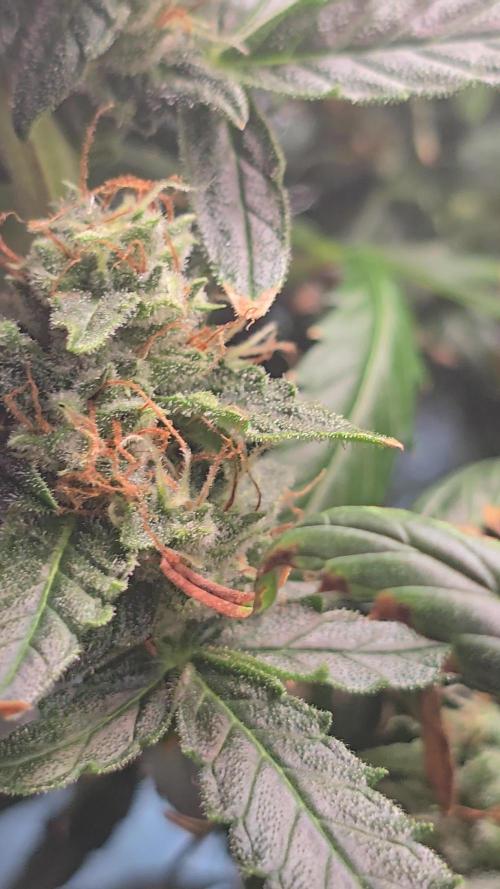The Grow Awards 2026 🏆 





























Likes
Comments
Share


@PlumpPelican
Follow
Pistils are slowly turning brown, trichomes cloudy and buds are ripening.
Started flushing the soil this week for the next 7-14 days depending on the progress of the plants.
Likes
151
Share


@BioBuds
Follow
Wow, isn't this 1 dollar seed performing :P The force is strong in this one. If I had to complain, the buds have a lot of leaves, but hey, were not...
What a joy to grow this strain, she is easy to grow and creates big buds, I hope she tastes like a Kush and we will be happy campers with this one.
The lights were a bit too close to her, she really didn't enjoy that light and heat, so we raised them, and after that growth went exponential in the buds again.
And this for two or three more weeks, depending on the trichomes which I like for a large part amber so add another week for this.
I'm guessing 1st week of January that she can be harvested, we shall see!
Don't forget to check out the Christmas deals at www.mars-hydro.com, if you are still in doubt, see in the lights page of the SP-3000, what the score is of this light and the results people have with it.
Thank you for visiting my journal again!
Hug Bud
Likes
7
Share


@BIYEI
Follow
Floracion (Tiempo estimado 64 dias)
Decima Semana de Floracion
11/03/2024 - 5:00hrs y 22hrs: Se hace cambio de cubeta y solucion, Se hace Lavado de cubetas, tuberias, bomba, humificador, y perifericos, Se realiza limpieza completa del indoor, Se verifican parámetros básicos del agua, mantener cuidados específicos, el olor empieza a ser mucho mas penetrante con solo abrir el indoor se nota el aroma muy delicioso, empiezan a observarse mas el crecimiento de los Cogollos.
Agua de osmosis: Ph 6.0, PPm 550-750, Ec 1.2-1.4, Temperatura 18°C - 24°C
Ambiente: Temperatura 19-25 °C, Humedad 55%, Ventilación 20%, 12 hrs de luz , 12 hrs de obscuridad.
12/03/2024 - 5:00hrs y 22hrs: Se verifican parámetros básicos del agua, mantener cuidados específicos.
Agua de osmosis: Ph 6.0, PPm 550-750, Ec 1.2-1.4, Temperatura 18°C - 24°C
Ambiente: Temperatura 19-25 °C, Humedad 55%, Ventilación 20%, 12 hrs de luz , 12 hrs de obscuridad.
13/03/2024 - 5:00hrs y 22hrs: Se verifican parámetros básicos del agua, mantener cuidados específicos.
Agua de osmosis: Ph 6.0, PPm 550-750, Ec 1.2-1.4, Temperatura 18°C - 24°C
Ambiente: Temperatura 19-25 °C, Humedad 55%, Ventilación 20%, 12 hrs de luz , 12 hrs de obscuridad.
14/03/2024 - 5:00hrs y 22hrs: Se verifican parámetros básicos del agua, mantener cuidados específicos.
Agua de osmosis: Ph 6.0, PPm 550-750, Ec 1.2-1.4, Temperatura 18°C - 24°C
Ambiente: Temperatura 19-25 °C, Humedad 55%, Ventilación 20%, 12 hrs de luz , 12 hrs de obscuridad.
15/03/2024 - 5:00hrs y 22hrs: Se verifican parámetros básicos del agua, mantener cuidados específicos.
Agua de osmosis: Ph 6.0, PPm 550-750, Ec 1.2-1.4, Temperatura 18°C - 24°C
Ambiente: Temperatura 19-25 °C, Humedad 55%, Ventilación 20%, 12 hrs de luz , 12 hrs de obscuridad.
16/03/2024 - 5:00hrs y 22hrs: Se verifican parámetros básicos del agua, mantener cuidados específicos.
Agua de osmosis: Ph 6.0, PPm 550-750, Ec 1.2-1.4, Temperatura 18°C - 24°C
Ambiente: Temperatura 19-25 °C, Humedad 55%, Ventilación 20%, 12 hrs de luz , 12 hrs de obscuridad.
17/03/2024 - 5:00hrs y 22hrs: Se verifican parámetros básicos del agua, mantener cuidados específicos.
Agua de osmosis: Ph 6.0, PPm 550-750, Ec 1.2-1.4, Temperatura 18°C - 24°C
Ambiente: Temperatura 19-25 °C, Humedad 55%, Ventilación 20%, 12 hrs de luz , 12 hrs de obscuridad.
Likes
30
Share


@CanadianFillmore
Follow
Welcome to week 4 of flower for the outdoors grow. Green Crack and LSD are continuing to pack on buds, the plants are still hungry and I've stepped up the total amount of feed I'm giving them, #gaiagreen power bloom.
Thanks for stopping by growfessors 👽🌳💚
Likes
5
Share


@KushSlayer
Follow
End of the week 5 of flowering
I have little bit problems with humidity 60-70% and i found something that doesnt look like good thing in bud :( but only in one lady
Overall ladies look good only one have something going, should i start flushing?
week 6 of flowering starts today
Likes
26
Share


@Highgrade_Harvests
Follow
Week 2 of flower is in the books and all 3 girls are looking extremely healthy. Perfect time to start packing on the weight. There are tons if bud sites that will get tons of light due to all the defoliation I've done. I've never defiliated plants this much before and I'm curious to see the difference in bud production below the canopy level. I love trying new things and experimenting with these plants. Always coming up with new ideas on how to do things and making things easier along the way. Can't wait to see how much I'll get off all 3 and see the difference in phenotypes.
Processing
Likes
12
Share


@Pauwela
Follow
7/14 girls are from 32" to 37" tall at 35 days old, looking good
Likes
59
Share


@Schneidersitz
Follow
Wir befinden uns am Ende der Bw5. Laut Fastbuds braucht dieser Strain 7 Wochen. Die ersten Pistillen färben sich braun. Die Kelche werden bald anschwellen. Der Duft nimmt weiter zu. Sehr schöne Pflanze bisher.
Likes
32
Share


@Sadhus
Follow
Bon le ph descend en flèche tout les jours, l' ec lui monte en flèche tout les jours, tout conseil est bien a prendre , quelque feuille brûlé sur les bords , et les pointes des feuilles qui se tortille
Likes
2
Share


@Viccrazyweed
Follow
Shit got out of control, i had to perform an LST to keep the big sister under control and she is the biggest plant I’ve ever grown although
She is developing buds everywhere and im not really sure but for me this is bad as i think sometimes less is more, its clear that the plant just can’t distribute the same nutrients on 10 buds/20buds, so i expect them to be soft and not potent, maybe THAT xxl pheno, im sure someone else could have get even more, shame that I can’t clone her
Little sister is looking so nice tho, Perfect structure, just amazing looking and beautiful to its maximum
Likes
26
Share


@ZombieKushAddicted
Follow
we will carry out this cultivation under the sponsorship of Mars Hydro with an FC-E 4800 lamp ,
to view this lamp or any other marshydro product go to: https://instagram.com/marshydro_aliexpress?igshid=YmMyMTA2M2Y=
Likes
34
Share


@RastaMouse
Follow
Week 7 of flower.
Ro water
Calmag 5 ml per 10l
A+b 30 ml per 10l
Ult pk 25 ml per 10l
Ph 6
Light 100%
Last week before I start flush. They are putting on size nice and have a warm baked smell to them.
Likes
2
Share


@Saintvicious
Follow
Keeps going. Etsy seeds coming through. I think soon in the grow a cal mag problem comes up. Chime in when you see it.
Likes
252
Share


@Tropicannibis_Todd
Follow
Well folks we chopped the Last of the Strawberry Blast 😁 The Strawberry Banana 🍌
Strawberry Blast Series 🍓 🍓 🍓 🍓 was a real blast , ive now done 5 Strawberry Cultivars and I'm extremely happy with all the results 😀 Killer Stuff 😀
I want to thank all my growmies for stopping in and showing your support 🙏 it's been much appreciated 🙏
Well my friends that's it for me for awhile😌
So until next time my friends 👉 Happy Growing and of course 🙂 Happy Smoking ........ Later Growmies 👊👊 be well 👌
FC4800 from MarsHydro Lights being readjusted and chart updated .........I've added a RU45 to the mix
www.marshydro.ca
👉I am using Agrogardens for nutrients for my grows and welcome anyone to give them a try .👈
👉 www.agrogardens.com 👈
Agrogardens Cal MAG
Agrogardens Grow A B
Agrogardens Bloom A B
Agrogardens Bud Booster
Agrogardens PK13/14
I GOT MULTIPLE DIARIES ON THE GO 😱 please check them out 😎
👉THANKS FOR TAKING THE TIME TO GO OVER MY DIARIES 👈
Would you like to hang with the growdiary community 👉 https://discord.gg/gr4cHGDpdb 👈
Likes
3
Share


@DjHairy
Follow
Week 11 and the buds are getting bigger. The tent still has a softer smell to it, not overwhelming at all. The buds are growing but still look like they need to plump. Tons of white hairs and frost developing. I’m still feeding nuts since it looks like it has some time still.


























